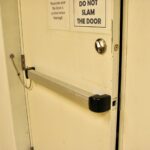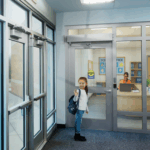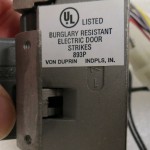Since Maine and Massachusetts have adopted the 2007 edition of NFPA 80 which requires the annual inspection of fire doors, we have received enough questions about it that I put together a list of frequently asked questions. Here they are:
The 2007 Edition of NFPA 80 – Standard for Fire Doors and Other Opening Protectives (Section 5.2 “Inspections”) requires all fire doors to be inspected not less than annually. As states, municipalities, and building/life-safety codes adopt or reference this edition of the standard, this requirement becomes effective and enforceable. Note: The 2010 edition of NFPA 80 contains the same requirements regarding inspections.
Who is responsible to make sure the inspections are performed?
It is the responsibility of building owners and property managers to initiate the inspections and produce written records of the inspections for the code official to review.
Who will perform the inspections?
NFPA 80 requires functional testing and inspections to be performed by “individuals with knowledge and understanding of the operating components of the applicable door type”.
Who are Intertek and the Door & Hardware Institute?
The Door & Hardware Institute, an industry association, has created a training program in conjunction with Intertek, a leader in testing and third-party certification. This is currently a 4-day course including a 4-hour exam, and there are 3 prerequisite courses. Those who pass the exam are eligible to become certified by Intertek as a Fire Door Assembly Inspector (FDAI).
Is the inspector required to be Intertek certified?
The Intertek certification assists building owners and code officials in identifying qualified inspectors, but NFPA 80 does not require this certification. Some code officials may prefer or require certification as a means of demonstrating knowledge and understanding of the products and applicable requirements.
What are the record-keeping requirements?
NFPA 80 does not detail the requirements for record-keeping except that the documentation must be signed, but code officials may have their own requirements. There are standardized forms available for Intertek-certified inspectors.
What will be checked during the inspection process?
(1) No open holes or breaks in the surface of the door or frame; no missing or broken parts
(2) Glazing, vision light frames, and glazing beads intact and securely fastened
(3) Door, frame, hinges, hardware, and thresholds secured, aligned, in working order and without damage
(4) Proper clearance between door and frame, between meeting stiles of pairs, and at bottom of door
(5) Self-closing devices and coordinators (where applicable) operational
(6) Latching hardware operates and secures door in closed position
(7) Auxiliary items that would interfere with operation are not installed
(8) No field modifications have been performed that void the label; labels are present and visible
(9) Gasketing and edge seals are present and in good condition
If deficiencies are found, when must they be repaired?
“Repairs shall be made and defects that could interfere with operation shall be corrected, without delay.” (5.1.5.1)
Is there another option for facilities with numerous fire doors?
The Performance-Based Option described in section 5.2.2 and Annex J is an alternate means of compliance that may be acceptable to the local code official. This option can extend the inspection cycle to up to 3 years.
.
Excerpt from the 2007 and 2010 Editions of NFPA 80 – Standard for Fire Doors and Other Opening Protectives
Reproduced with permission from NFPA 80, Fire doors and Other Opening Protectives, Copyright© 2007, 2010, National Fire Protection Association. This reprinted material is not the complete and official position of the NFPA on the referenced subject, which is represented only by the standard in its entirety.
5.2* Inspections.
5.2.1* Fire door assemblies shall be inspected and tested not less than annually, and a written record of the inspection shall be signed and kept for inspection by the AHJ.
5.2.2* Performance-Based Option.
5.2.2.1 As an alternate means of compliance with 5.2.1, subject to the AHJ, fire door assemblies shall be permitted to be inspected, tested, and maintained under a written performance based program.
5.2.2.2 Goals established under a performance-based program shall provide assurance that the fire door assembly will perform its intended function when exposed to fire conditions.
5.2.2.3 Technical justification for inspection, testing, and maintenance intervals shall be documented.
5.2.2.4 The performance-based option shall include historical data acceptable to the AHJ.
5.2.3 Functional Testing.
5.2.3.1 Functional testing of fire door and window assemblies shall be performed by individuals with knowledge and understanding of the operating components of the type of door being subject to testing.
5.2.3.2 Before testing, a visual inspection shall be performed to identify any damaged or missing parts that can create a hazard during testing or affect operation or resetting.
5.2.4 Swinging Doors with Builders Hardware or Fire Door Hardware.
5.2.4.1 Fire door assemblies shall be visually inspected from both sides to assess the overall condition of door assembly.
5.2.4.2 As a minimum, the following items shall be verified:
(1) No open holes or breaks exist in surfaces of either the door or frame.
(2) Glazing, vision light frames, and glazing beads are intact and securely fastened in place, if so equipped.
(3) The door, frame, hinges, hardware, and noncombustible threshold are secured, aligned, and in working order with no visible signs of damage.
(4) No parts are missing or broken.
(5) Door clearances at the door edge to the frame, on the pull side of the door, do not exceed clearances listed in 4.8.4 and 6.3.1.
(6) The self-closing device is operational, that is, the active door completely closes when operated from the full open position.
(7) If a coordinator is installed, the inactive leaf closes before active leaf.
(8) Latching hardware operates and secures the door when it is in the closed position.
(9) Auxiliary hardware items that interfere or prohibit operation are not installed on the door or frame.
(10) No field modifications to the door assembly have been performed that void the label.
(11) Gasketing and edge seals, where required, are inspected to verify their presence and integrity.
You need to login or register to bookmark/favorite this content.






I am interested in the door size of 32″ as I understand it states that anything smaller is not to be tagged. If there is a 30″ door rated it will not be allowed. I am wondering if there is double door and each door is less 32″ is there a problem for the pair of doors?
Hi Robert –
There are 2 issues – egress, and UL’s recent change regarding doors less than 32″ wide.
For egress, a single door needs to provide at least 32″ clear, measured from the stop on the frame to the face of the door with the door open 90 degrees. For a pair, at least one leaf needs to provide 32″ clear, measured from the edge of one leaf in the closed position, to the face of the other leaf in the 90-degree position. Here’s a blog post on clear width: http://idighardware.com/2009/07/clear-opening-width/
Regarding fire doors, UL has recently issued a bulletin stating that any fire door less than 32″ wide must be specifically tested rather than being covered when a larger size is tested. This may change in the future, but for now all of the information I know is included on this post: http://idighardware.com/2012/08/ul-fire-doors/. We don’t know how this will affect existing fire doors or their inspection.
HI Lori
Thanks for that info and it will be very interesting on the next release from ul as per the existing fire doors. I think that is a whole new game as most we talk to on the door inspection issue is that they just check the basics on the door and not interested (just the way they talk) that they have a door issues “as long as the door works”…..
Hi Lori;
I have been asked this question continually and I would like you to assist in providing an up-to-date answer…
How may states are currently doing the Fire Door Inspection Initiative?
Hi Shawn –
There is no master list of which states are enforcing fire door inspections. Generally, if the state has adopted a fire code that references NFPA 80-2007 or later, and if there is language in the adopted fire code stating that fire door assemblies must be maintained in accordance with NFPA 80, then you can draw a line between the fire code requirement and the inspection requirement in 80. In addition, health care facilities that receive funding from CMS are required to have annual fire door inspections, regardless of what the state codes require. Here is some more information on that: http://idighardware.com/2016/05/decoded-changes-to-the-life-safety-code-for-health-care-occupancies/. And here’s another post, where I asked the Joint Commission whether they will be enforcing the annual inspection requirement: http://idighardware.com/2016/06/wwyd-fire-door-inspections/
– Lori